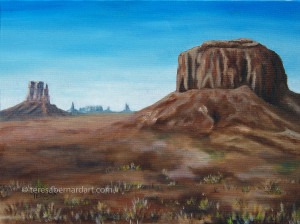How Is Depth Created in Twodimensional Works of Art

by Teresa Bernard
Depth is a basic building block of all visual art. What makes it such an important chemical element is that information technology creates a strong sense of reality in a painting. It can exist defined as the illusion of distance or three-dimension on a ii-dimensional or flat surface. A lack of depth in a composition means it volition be less than lifelike. Therefore 1 can run into but how of import creating depth on a flat surface is.
Creating Depth
Primary techniques an artist tin can use to create depth in a painting are (i) layering and overlapping, (2) changing size and placement, (three) linear perspective, and (4) relative color, hue, and value. Let me explain each of these.
Layering and overlapping are placing 1 or more than elements in forepart of some other element to create the illusion of depth in the composition. Objects that announced in front of others seem nearer, while those behind seem further away. This method is the strongest way of creating depth, and it will override all other signs when at that place is a seeming conflict.
Irresolute size and placement is another method artists use to create a sense of depth in a painting. This technique states that larger objects appear closer and smaller objects announced further abroad. Also, objects positioned at the lesser of the painting appear to exist in front, and those at the acme appear to be in the back.
Linear perspectiveallows artists to give the impression of depth by the property of parallel lines converging in the distance at infinity. An case of this would exist standing on a direct road, looking down the road, and noticing the route narrows as it goes off in the distance. The signal of infinity is what is called a vanishing indicate. These lines don't actually demand to be visible, though they can be. The objects in the limerick can besides imply them.
For more information about using perspective to add dimension to your paintings, read the article titled The Rules of Perspective Drawing.
Relative color, hue, and value can also add the illusion of depth.
-
- Darker colors look closer to the viewer, and lighter colors look farther away.
- Colors that are close in value seem close to each other, and strongly contrasting colors appear to split.
- Warm, bright colors (red-orangish, yellow) seem to advance towards the foreground, and cool, dark colors (blue and bluish dark-green and majestic) seem to recede into the background.
- Saturated colors seem to accelerate, and low saturated colors seem to recede.
Other things to consider are:
Lighting and Shading — Calorie-free adds depth by casting external shadows. It besides shows depth in how it acts over the surface of one object. The closer to the low-cal source, the brighter the surface is with more reflected lite.
Cast and drop shadows are another common way to add depth. Reflections work similarly in that a reflection appears on a dissimilar surface. The illusion of depth tin can be increased by making the shadow larger and lighter and further abroad from the object. Blurring the edges of shadows as well increases the illusion of depth.
Focus, Texture, and Particular — Objects that are more detailed, sharper in focus, and more textured announced closer than those with less item, blurred, or little or no texture are perceived as far abroad.
*Click for more than information about the basic elements of fine art.
Boosted Reading
Using Atmospheric Perspective to Create Depth in Your Paintings
Have a question?
If you have a question about this painting, please contact us, and nosotros'll exist happy to respond any of your questions.
Thanks for reading this!
Feel gratuitous to share this with your friends.
Enjoy this page? Delight share information technology. Thanks!
Source: http://teresabernardart.com/creating-depth-on-a-flat-surface/